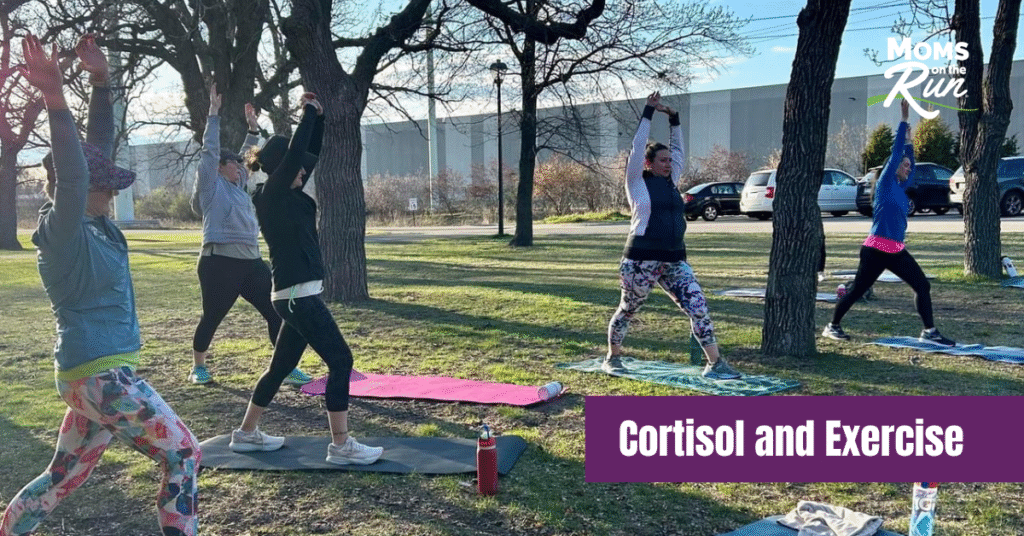You don’t have to look far to find a social media post claiming that running and other high intensity exercise is bad for you, especially after a certain age, because it leads to an increase in cortisol. Influencers state that high cortisol increases belly fat, prevents weight loss and causes other health problems. Is this information accurate? Does exercise increase cortisol and cause weight gain or is the physiology more complicated than that? Here is the skinny on cortisol and exercise.
What is Cortisol?
Cortisol is an essential hormone produced in your body by your adrenal glands. Almost all tissues in the body have cortisol receptors, which means cortisol has an important role in regulation of multiple body functions, including metabolism and inflammation. Cortisol is so important that without it, you will die.
Cortisol is normally elevated in the morning and decreases as the day progresses. Levels are typically lowest in the evenings to facilitate sleep. Cortisol levels also rise when your body encounters stress. This is a normal, temporary and beneficial response to prepare your body for “fight or flight.”
Cortisol Response to Exercise
Your body views exercise as a stressor, so it is true that cortisol increases temporarily with exercise. Cortisol levels rise more for high intensity exercise or long duration cardio exercise than low intensity workouts, but this is not necessarily negative. The increase in cortisol promotes breakdown of glucose and fat to supply the energy needed for the exercise. Cortisol also helps the body learn how to respond to stress, so that equal levels of stress in the future result in a lower cortisol response. Some studies have even found a decreased cortisol response to other forms of life stress following exercise. Cortisol levels quickly fall after exercise ends.
Chronic Elevation of Cortisol
Problems begin when the body is exposed to chronically high levels of stress without adequate levels of recovery. This occurs after too many days of long intense workouts with inadequate recovery in terms of rest, sleep and nutrition. Ironically, consistent under fueling also raises cortisol levels. Your body does not really differentiate between different types of stress, so chronic cortisol elevation can also result from high levels of work or family stress or a combination of hard training and life stress.
The symptoms of chronic stress and overtraining are very similar: fatigue, poor sleep, lack of motivation, frequent illness and an increased resting heart rate. Chronically high levels of cortisol are also linked to high blood pressure and metabolic dysfunction. Fatigue and poor sleep can make it difficult to lose weight and metabolic dysfunction is associated with belly fat; perhaps these are the original source of the influencer claims.
Finding Balance Between High Intensity Exercise, Life Stress and Recovery
High intensity exercise has too many benefits to give it up! It is a time efficient way to build cardiovascular endurance and strong bones. High intensity workouts often provide greater activation of type 2 “fast twitch” muscle fibers, helping you maintain greater power and explosive strength as you age. High intensity exercise can even decrease other forms of life stress and improve mood.
Try to find balance between high and low intensity exercise, life stressors and recovery. Use your general level of fitness to determine frequency: beginners could start with one day per week of high intensity. More experienced athletes can handle two to three high intensity workouts if these workouts are balanced with short easy runs, walking, or other forms of exercise like yoga and Pilates. Getting enough sleep and high-quality nutrients in sufficient amounts to fuel and recover from your more intense workouts is absolutely essential. Consider your total amount of life stress when planning your workouts as well.
Take Home Message
It is beneficial to include high intensity or long duration cardiovascular exercise in your usual routine. The key in preventing the negative effects of chronic cortisol elevation is balancing these hard training sessions with adequate recovery in terms of good nutrition, sleep, and less intense workouts.
 About the Author: Kristen Gerlach, PT, PhD is an avid runner and physical therapist with 30 years of experience. She also holds a PhD in Exercise Science. Kristen specializes in working with runners for injury treatment and prevention, running performance, strength training, and 3D gait analysis.
About the Author: Kristen Gerlach, PT, PhD is an avid runner and physical therapist with 30 years of experience. She also holds a PhD in Exercise Science. Kristen specializes in working with runners for injury treatment and prevention, running performance, strength training, and 3D gait analysis.
Want to learn more or have a question for Kristen? Contact her by email or visit her website.
